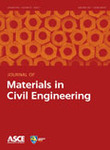Journal


Journal of Materials in Civil Engineering
Archives Papers: 713
The American Society of Civil Engineers
Please choose volume & issue:
-
Enhancing Residual Characteristics of Concrete with Recycled Refractory Brick Fine Aggregate after Exposure to Elevated Temperature: An Experimental Study
Abstracts:Abstract Residual prominences of concrete are of specific concern, as exposure to elevated temperatures adversely influences its characteristics. The current study strives to develop heat-resistant sustainable concrete by incorporating recycled refractory brick as an alternative to typical fine aggregate considering ordinary portland cement as binder material. Eight distinct concrete blends have been prepared starting from 10% to 100% replacement levels and subsequently exposed to 200, 400, 600, 800, 1,000, and 1,200°C temperatures. A mass loss of 0.36%–8.76% and density loss of 0.4%–11.73% were observed as the temperature rises from 200 to 1,200°C. 6.05%, 23.16%, 43.53%, 70.90%, 82.83%, and 90.73% reduction in ultrasonic pulse velocity values and 13.21%, 40.72%, 67.80%, 91.68%, 97.05%, and 99.11% increments in damage degree have been noticed upon exposure to the identical temperature regimes, respectively. 98.1%, 74.8%, 35.9%, 13.5%, 3.3%, and 2.4% dynamic modulus of elasticity values have been retained by the samples upon submission to identical temperatures. The outcomes indicate the formation and development of surface cracks and internal cracks with the growth in temperature. The compressive strength has an improvement of up to 28% for the specimens with 20% fine aggregate replacement with RRB at 200°C, 63% for both 20% and 30% replacement at 400°C. Similarly, the same trend of improvement existed in compressive strength by 53% for the specimens with 30% fine aggregate replacement with RRB at 600°C, elucidating improved ceramic bonding due to the incorporation of recycled refractory brick aggregates. Additionally, it was found that a higher amount of recycled refractory brick (50%–100% replacement levels) rather than typical fine aggregate considerably reduces the density and weight losses at higher temperatures. In the authors’ opinion, the concrete specimens with 10%–30% replacements may be considered as promising and potential concrete blends for diverse practical applications under the scope of the present investigation.
Hot Journals
- Risk Breakdown Matrix for Risk-Based Inspection of Transportation Infrastructure Projects
- Social Control in Outsourced Architectural and Engineering Design Consulting Projects: Behavioral Consequences and Motivational Mechanism
- 2022 Best Paper Award
- Hold-Ups and Failures in Negotiated Order: Unearthing the Nuances of Rework Causation in Construction
- Prevalence and Risk Factors for Poor Mental Health and Suicidal Ideation in the Nigerian Construction Industry
- CFRP–Cable-Stayed Bridge Hybrid with Partial Suspension and a Span Exceeding 3,000 m: Concept, Optimization, and Construction
- Impact of Wind Load Characteristics on Computed Bridge Stay-Cable Forces Used for Bridge Health Monitoring
- Weak-End and Frequency Detection of Elastically Supported Bridges by Contact Residual Response of Two-Axle Test Vehicle in a Round Trip
- Development of Performance-Based Fragility Curves of Coastal Bridges Subjected to Extreme Wave-Induced Loads
- An Analytical Model to Evaluate Short- and Long-Term Performances of Post-Tensioned Concrete Box-Girder Bridges Rehabilitated by an Ultrahigh-Performance Concrete Overlay
- Three-Dimensional Velocity Distribution in Straight Smooth Channels Modeled by Modified Log-Law
- Experimental Investigation on Flow Past Two and Three Side-by-Side Inclined Cylinders
- An Experimental Investigation of Rotor–Box Aerodynamic Interaction 1
- Modeling Gas–Liquid Flow Between Rotating and Nonrotating Annular Disks
- Entry Length Requirements for Two- and Three-Dimensional Laminar Couette–Poiseuille Flows
Advanced Materials (3,745)
- Structured Perovskite Light Absorbers for Efficient and Stable Photovoltaics
- Strategies for High‐Performance Solid‐State Triplet–Triplet‐Annihilation‐Based Photon Upconversion
- Atomic Engineering Catalyzed MnO2 Electrolysis Kinetics for a Hybrid Aqueous Battery with High Power and Energy Density
- Crystal Adaptronics: Global Performance Indices for Dynamic Crystals as Organic Thermal Actuators (Adv. Mater. 20/2020)
- Enlightening Materials with Photoswitches
Acta Astronautica (1,768)
- Mixed-integer trajectory optimization with no-fly zone constraints for a hypersonic vehicle
- Adaptive control design for active Pogo suppression of large strap-on liquid launch vehicles
- Machine learning based approach for modeling and forecasting of GPS–TEC during diverse solar phase periods
- Effect of two-dimensional micro-cavity surface on hypersonic boundary layer
- Investigation on burning behaviors of aluminum agglomerates in solid rocket motor with detailed combustion model








 User Center
User Center My Training Class
My Training Class Feedback
Feedback




